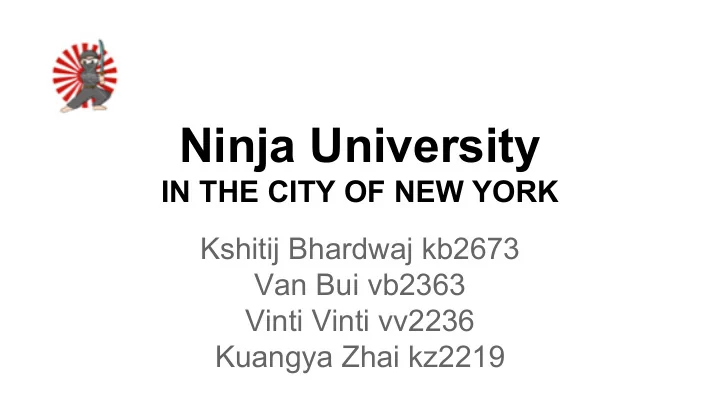

Ninja University IN THE CITY OF NEW YORK Kshitij Bhardwaj kb2673 Van Bui vb2363 Vinti Vinti vv2236 Kuangya Zhai kz2219
Overview ● Wiimote controlled object slicing game on SoCKit board ● Motivated by Fruit Ninja game ● Storyline : To become a Ninja, you must be very diligent and fulfill program requirements by slicing your assignments, exams, write your thesis, etc ● Strategy to become a Ninja ○ Slice objects to increase your score ○ Avoid slicing an F object ○ Slice objects before they disappear from the screen
Image Preprocessing ● Images for stationary and moving objects ● Generate a memory initialization file for each image ● Single-port ROM memory blocks ● 12-bit index color, i.e. 4096 colors
Audio Preprocessing ● Background music and sound effects ● Ogg Vorbis decoding - conversion to MIF format ● Single-port ROM memory blocks ● Sampling rate: 44100 Hz ● Quantization bits: 16 bits ● Edit audio files for length, channels, and sampling rate
Hardware Design
VGA DISPLAY MODULES
RGB Controller ● Sprite selection and movement controlled by software ● Hardware generates images ● Line buffer write operation ● Priority encoder for sprites
Line Buffer Write Operation ● Two line buffers used for reading and writing ● Write at alternate rows
Sprite selection logic ● Sprite selection and position based on control input (on/off flag and coordinates) from game logic. ● Flag checking, calculation of address, data fetching done using combinational logic, in parallel for all layers (to ensure no timing issues). ● Priority encoder used for selecting the pixel to be written into line buffer. ● Writing into line buffer using sequential logic at 25MHz clock frequency. ● Used combinational logic to simplify design, other options could be pipelining/ interleaving.
List of Sprites Block Number of Size of Images Total ROM size Sprites (pixels) (bytes) Numbers 10 32x32 61440 Lives 1 32x32 1536 Ninja 3 64x64 18432 Weather 3 64x64 18432 Slicing 6 64x64 36864 Objects Level 3 64x64 18432 Selection Try Again 1 64x64 6144 Diploma 1 64x64 6144 NYC 3 200x160 144000 Skyline Pass/Fail 2 64x64 96000 Total 33 401.28 KB
Audio Controller: Major Components ● Audio Data ○ Audio Samples stored in ROM blocks ● Audio Codec Configuration Interface ○ Configure audio codec SSM2603 ● Digital Audio Interface ○ Send audio samples from ROM to audio codec at audio clock rate
Audio ROM blocks ● Two sounds converted from ogg file format to mifs: ○ city.mif : Background music ○ sword.mif: Ninja striking an object sound ● Both sounds stored in ROM blocks ○ city: 16 bit samples, 16537 words ○ sword: 16 bit samples, 22049 words ○ total size: 77 KB
Audio Codec Configuration Interface ● Uses I2C protocol to configure 16 9-bit registers in audio codec SSM 2603 ● Configured parameters include ○ Volume (0 db) ○ Mode (slave) ○ Sampling rate (44.1 khz) ○ Power on/off
Audio Codec Interface ● Operates at audio clock (11.3 Mhz) ● Implemented as Shift registers that send audio samples to audio codec ● Two clocks derived from audio clock ○ Channel clock: Time multiplexed, send sample on one channel (left or right) at a time ○ Bit clock: send a bit of each sample
Audio Codec Interface: Operation
Kernel Device Driver Modules ● VGA device driver ○ Ioctl calls to write positions (x,y) of sprites, scores, remaining lives, select screens, select levels ○ VGA peripheral memory: 4-bit address, 16-bit words ● Audio device driver ○ Ioctl calls to control (on/off) of sword sound ○ Audio peripheral memory: 1-bit address, 16-bit word ○ Can be easily extended to control other sounds...
Debugging Methods ● System console scripts to test hardware ○ Audio sound ○ Sprites display ● Modelsim ● Modular design coding
Wiimote Controller ● Peripherals ○ wiimote, infrared sensor light, bluetooth USB dongle ● Software ○ Libwiimote (C-library) ○ Linux Device Driver: BlueZ, libwiimote-dev ● Recognize the infrared source on the screen ● Cast the screen size from 1784 x 1272 to 640 x 480 ● Vibrate when cutting the bomb
Game Logic ● Implemented in the software world by C ● Interaction between user and hardware ○ User: bluetooth dongle connected to USB ○ Hardware: VGA and audio device driver ● Do the computation and control the game... ○ Input: infrared source position from wiimote ○ Output: current screen, position of sprites, ninja, enabling the sound and vibration, score, life...
Experiences and Issues ● Wiimote connection takes longer than expected ● Codesign by contract in the favor of the hardware ● Interfacing with audio codec were the most difficult ● Audio buffers and interrupts ● Limited on-chip memory space
Lessons Learned ● Architecture design of SoCKit board ● Software and hardware co-design ● Collaborative coding ● Time management ● SoCKit tutorials by Howard Mao were very helpful ● Simple implementation first, then optimize as needed
Demo
Recommend
More recommend